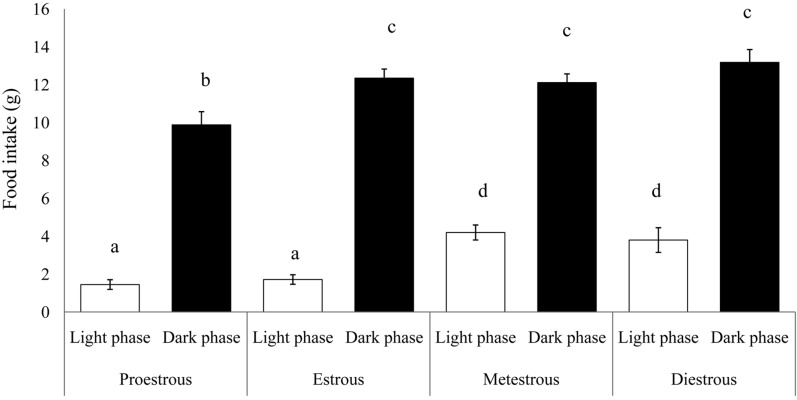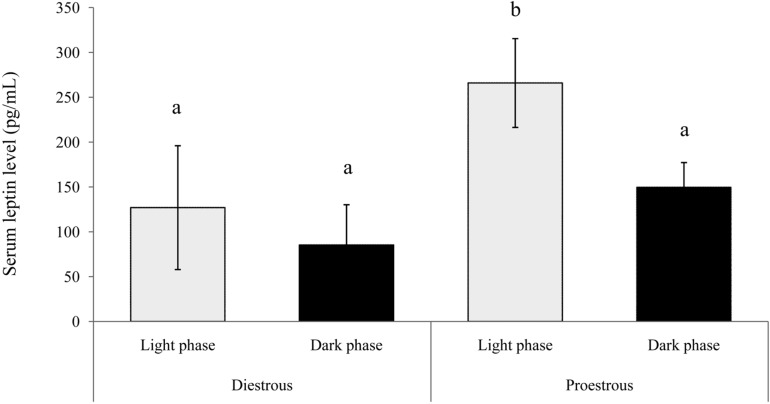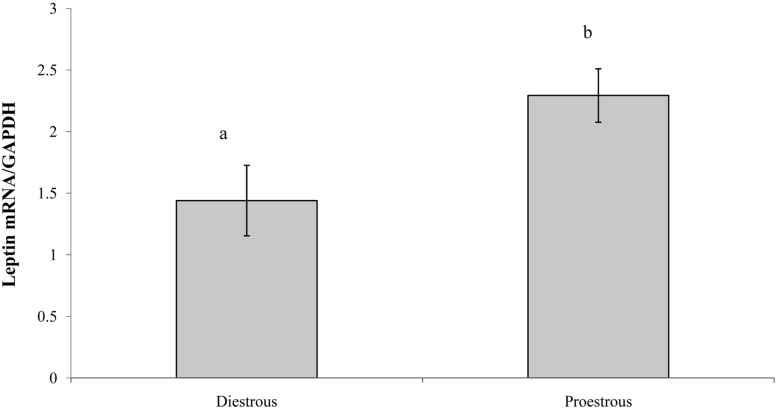Lab Anim Res.
2013 Mar;29(1):1-6. 10.5625/lar.2013.29.1.1.
Serum leptin concentrations, leptin mRNA expression, and food intake during the estrous cycle in rats
- Affiliations
-
- 1Behavioral Neuroscience Laboratory, Graduate School of Veterinary Medicine, Nippon Veterinary and Life Science University, Tokyo, Japan. trsaito@nvlu.ac.jp
- 2Laboratory of Animal Physiology, Nippon Veterinary and Life Science University, Tokyo, Japan.
- 3Department of Laboratory Animal science, Dokkyo University School of Medicine, Tochigi, Japan.
- 4Faculty of Pharmaceutical Sciences, University of Iceland, Reykjavik, Iceland.
- 5Department of Experimental Medicine, University of Copenhagen, Copenhagen, Denmark.
- 6Department of Veterinary Anatomy, College of Veterinary Medicine, Chonnam National University, Gwangju, Korea.
- 7Department of Zoology, Faculty of Science, Kasetsart University, Bangkok, Thailand.
- KMID: 2312096
- DOI: http://doi.org/10.5625/lar.2013.29.1.1
Abstract
- The aim of this study was to investigate food intake, serum leptin levels, and leptin mRNA expression during the sexual cycle in rats. Female Wistar-Imamichi rats aged 8-10 weeks were used in this experiment. Food intake was measured during the light and dark phases (light on at 07:00 and off at 19:00) of the 4-day estrous cycle in female rats. Serum leptin levels were measured by ELISA, and leptin mRNA expression levels were analyzed using real-time PCR on diestrous- and proestrous-stage rats. Our results revealed that during the sexual cycle, food intake was significantly higher in the dark phase compared with the light phase. Food intake in proestrous females was significantly lower in the light and dark phases compared with the other groups. Serum leptin concentrations were significantly higher in both phases in proestrous rats compared with diestrous rats. There was a significant increase in leptin mRNA expression in adipose tissue during the proestrous period compared with the diestrous period. These findings suggest that increased leptin mRNA expression and serum leptin levels, which are induced by estrogen during the proestrous stage, may play a role in regulating appetitive behavior.
Keyword
MeSH Terms
Figure
Cited by 1 articles
-
Effects of estrogen on food intake, serum leptin levels and leptin mRNA expression in adipose tissue of female rats
Wirasak Fungfuang, Misao Terada, Noriyuki Komatsu, Changjong Moon, Toru R. Saito
Lab Anim Res. 2013;29(3):168-173. doi: 10.5625/lar.2013.29.3.168.
Reference
-
1. Sjoholm K, Carlssom B, Carlsson LMS. Hypothalamic response to leptin changes during a hormonally induced estrous cycle in rats. Cent Eur J Biol. 2006; 1:221–234.2. Schneider JE. Energy balance and reproduction. Physiol Behav. 2004; 81:289–317. PMID: 15159173.
Article3. Gray JM, Wade GN. Food intake, body weight, and adiposity in female rats: actions and interactions of progestins and antiestrogens. Am J Physiol. 1981; 240(5):E474–E481. PMID: 7195153.
Article4. Wade GN, Heller HW. Tamoxifen mimics the effects of estradiol on food intake, body weight, and body composition in rats. Am J Physiol. 1993; 264:R1219–R1223. PMID: 8322977.
Article5. Tritos NA, Segal-Lieberman G, Vezeridis PS, Maratos-Flier E. Estradiol-induced anorexia is independent of leptin and melanin-concentrating hormone. Obes Res. 2004; 12(4):716–724. PMID: 15090642.
Article6. Koochmeshgi J. Reproductive switch and aging: the case of leptin change in dietary restriction. Ann N Y Acad Sci. 2004; 1019:436–438. PMID: 15247061.
Article7. Saito TR, Suzuki M, Aoki-Komori S, Tanaka M. Food intake and leptin concentrations of lactating rats nursing various sized litters. Reprod Med Biol. 2005; 4:203–206.
Article8. Martin B, Golden E, Carlson OD, Egan JM, Mattson MP, Maudsley S. Caloric restriction: impact upon pituitary function and reproduction. Ageing Res Rev. 2008; 7(3):209–224. PMID: 18329344.
Article9. Nagatani S, Guthikonda P, Thompson RC, Tsukamura H, Maeda KI, Foster DL. Evidence for GnRH regulation by leptin: leptin administration prevents reduced pulsatile LH secretion during fasting. Neuroendocrinology. 1998; 67(6):370–376. PMID: 9662716.
Article10. Marcondes FK, Bianchi FJ, Tanno AP. Determination of the estrous cycle phases of rats: some helpful considerations. Braz J Biol. 2002; 62:609–614. PMID: 12659010.
Article11. Asakuma S, Hiraku O, Kurose Y, Kobayashi S, Terashima Y. Diurnal rhythm of cerebrospinal fluid and plasma leptin levels related to feeding in non-lactating and lactating rats. J Endocrinol. 2004; 180(2):283–286. PMID: 14765980.
Article12. ter Haar MB. Circadian and estrual rhythms in food intake in the rat. Horm Behav. 1972; 3(3):213–219. PMID: 4681745.13. Nagatani S, Guthikonda P, Foster DL. Appearance of a nocturnal peak of leptin secretion in the pubertal rat. Horm Behav. 2000; 37(4):345–352. PMID: 10860678.
Article14. Brobeck JR, Wheatland M, Strominger JL. Variations in regulation of energy exchange associated with estrus, diestrus and pseudopregnancy in rats. Endocrinology. 1947; 40(2):65–72. PMID: 20286603.15. Blaustein JD, Wade GN. Ovarian influences on the meal patterns of female rats. Physiol Behav. 1976; 17(2):201–208. PMID: 1033580.
Article16. Bennett PA, Lindell K, Wilson C, Carlsson LM, Carlsson B, Robinson IC. Cyclical variations in the abundance of leptin receptors, but not in circulating leptin, correlate with NPY expression during the oestrous cycle. Neuroendocrinology. 1999; 69(6):417–423. PMID: 10364693.
Article17. Tanaka M, Nakaya S, Kumai T, Watanabe M, Tateishi T, Shimizu H, Kobayashi S. Effects of estrogen on serum leptin levels and leptin mRNA expression in adipose tissue in rats. Horm Res. 2001; 56(3-4):98–104. PMID: 11847470.
Article18. Zeng J, Patterson BW, Klein S, Martin DR, Dagogo-Jack S, Kohrt WM, Miller SB, Landt M. Whole body leptin kinetics and renal metabolism in vivo. Am J Physiol. 1997; 273:E1102–E1106. PMID: 9435524.
Article19. Amico JA, Thomas A, Crowley RS, Burmeister LA. Concentrations of leptin in the serum of pregnant, lactating, and cycling rats and of leptin messenger ribonucleic acid in rat placental tissue. Life Sci. 1998; 63(16):1387–1395. PMID: 9952284.
Article20. Frederich RC, Löllmann B, Hamann A, Napolitano-Rosen A, Kahn BB, Lowell BB, Flier JS. Expression of ob mRNA and its encoded protein in rodents. Impact of nutrition and obesity. J Clin Invest. 1995; 96(3):1658–1663. PMID: 7657836.
Article21. Rocha M, Grueso E, Puerta M. The anorectic effect of oestradiol does not involve changes in plasma and cerebrospinal fluid leptin concentrations in the rat. J Endocrinol. 2001; 171(2):349–354. PMID: 11691655.
Article22. Kristensen K, Pedersen SB, Richelsen B. Regulation of leptin by steroid hormones in rat adipose tissue. Biochem Biophys Res Commun. 1999; 259(3):624–630. PMID: 10364468.
Article
- Full Text Links
- Actions
-
Cited
- CITED
-
- Close
- Share
- Similar articles
-
- Effects of estrogen on food intake, serum leptin levels and leptin mRNA expression in adipose tissue of female rats
- Metformin Enhances Leptin Sensitivity in Aged Rats
- Regulation of Leptin and Resistin Gene Expression:Roles in Food Intake and Glucose Metabolism
- Leptin: It's Role in Food Intake and Body Weight Control
- The Effect of Leptin Level Fluctuations by a Repeated Fasting/Refeeding on the Leptin Sensitivity in OLETF Rats




